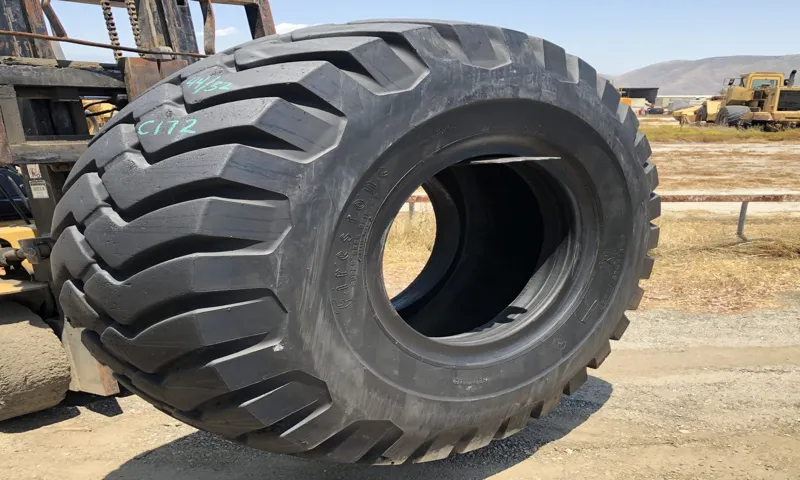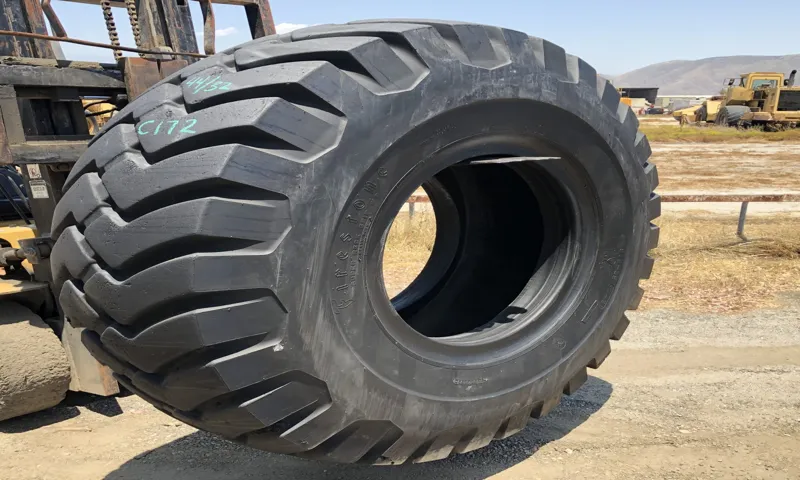As a vehicle owner or driver, you may have heard the term “OTR tires” being thrown around without really understanding what they are. It can be intimidating to ask for an explanation, but fear not! We’ve got you covered. In this blog post, we’ll break down what OTR tires are, how they differ from regular tires, and why they’re important for heavy-duty vehicles that operate in off-road conditions.
So buckle up and get ready to learn!
What are OTR Tires?
If you’re in the world of heavy machinery, you’ve probably heard the term “OTR tire” thrown around. But what exactly is an OTR tire? OTR, or off-the-road, tires are specifically designed for heavy equipment that operates in tough terrains, like construction sites, mines, and quarries. Unlike regular car tires, OTR tires are massive and built to handle the weight and stress of heavy machinery.
They have thicker treads and stronger rubber compounds, making them resistant to punctures, cuts, and other damages. OTR tires come in various sizes, and their prices can range from a few hundred dollars to thousands of dollars. They play a crucial role in the industry, helping heavy equipment operate efficiently and safely.
So, the next time you see a massive tire on a construction site, know that it’s most likely an OTR tire, specially built to handle the most challenging working conditions.
Definition and Function
OTR tires, also known as off-the-road tires, are specialized tires used on heavy-duty vehicles that operate off the typical paved roads. These rugged tires are designed for heavy machinery like dump trucks, bulldozers, and excavators. They differ from regular tires in their larger size, deeper treads, and stronger construction that allows them to handle rough terrain and heavy loads.
OTR tires are commonly used on construction sites, farms, mines, and other industries where vehicles need to navigate rocky, muddy, or uneven surfaces. Their unique design and features provide increased traction, stability, and durability, improving the overall efficiency and safety of vehicle operations in these challenging environments. If you operate heavy equipment on off-road terrains, investing in high-quality OTR tires can significantly reduce downtime, increase productivity, and prevent accidents on the job site.

Industries that Use OTR Tires
OTR Tires OTR (Off-The-Road) tires are heavy-duty tires designed for use on off-road vehicles such as mining trucks, bulldozers, and heavy equipment used in construction sites. These tires differ from regular tires in their design, build, and construction. OTR tires are bigger and thicker than regular tires as they are subjected to harsh conditions and are needed to carry heavy loads.
The main industries that use OTR tires include construction, mining, agriculture, and forestry. The construction industry uses OTR tires in excavators, backhoes, and other earthmoving machines. The mining industry uses them in dump trucks, loaders, and excavators, while agricultural vehicles such as tractors also use OTR tires.
The forestry industry uses them on skidders and harvesters to navigate through rough terrain. OTR tires are designed to perform in extreme conditions, providing durability, strength, and resistance to punctures and cuts. Their unique design and build make them crucial for industries that operate off-road vehicles and machinery in harsh environments.
Types of OTR Tires
An OTR tire, or Off-The-Road tire, is a large, heavy-duty tire designed for use on construction, mining, and industrial equipment that operate in harsh environments. There are several types of OTR tires, including bias ply tires, radial tires, and solid tires. Bias ply tires are made with overlapping layers of rubber and fabric cords, providing excellent puncture resistance and durability.
Radial tires, on the other hand, have steel belts that help them resist high speeds and heat better than bias ply tires. Solid tires are often used on heavy-duty equipment like forklifts, and are made entirely of solid rubber, providing excellent durability and resistance to cuts and punctures. Regardless of the type of OTR tire, they are all designed to provide maximum traction and stability in even the toughest conditions.
Whether you need an OTR tire for a mining truck or a bulldozer, there is a type of tire available to meet your needs.
Rigid Dump Truck Tires
When it comes to rigid dump truck tires, there are various types of OTR tires available in the market. These tires are specially designed to handle heavy loads and rough terrains. The most commonly used types of OTR tires for rigid dump truck applications are radial tires, bias ply tires, and dual-compound tires.
Radial tires are known for their durability, long lifespan, and high fuel efficiency. Bias ply tires, on the other hand, offer better traction and stability on uneven surfaces. Dual-compound tires are a combination of radial and bias ply tires, providing both durability and increased grip.
Choosing the right type of OTR tire for your rigid dump truck can greatly impact your productivity and efficiency. Therefore, it’s important to consider factors like load capacity, terrain, and operating conditions before making a purchase. Good maintenance practices, such as regular tire rotation and proper inflation, can also increase the life of your tires and improve your vehicle’s performance and safety on the job site.
Loader Tires
Loader Tires When it comes to off-the-road (OTR) tires, there are various types to choose from, including loader tires. Loader tires are specifically designed to handle the weight and power of wheel loaders, which are heavy-duty machines used in construction and mining. These tires need to have a strong carcass structure that can withstand the heaviest loads, while also having a deep and durable tread pattern for excellent grip.
There are several types of loader tires available, including bias and radial options. Bias tires have a more robust construction and are best suited for severe operating conditions. Radial tires, on the other hand, provide better traction and minimize rolling resistance, making them ideal for high-speed applications.
When selecting the right loader tire for your needs, it’s essential to consider the application, machine specifications, and operating conditions. With the right choice, you can ensure maximum performance, increased efficiency, and reduced downtime for your wheel loader.
Grader Tires
Grader tires are an essential component for any construction site, particularly when it comes to heavy equipment like graders. There are a few different types of OTR (off-the-road) tires that are ideal for graders. First, there are bias ply tires, which are known for their superior stability and traction.
They’re built with a stiffer sidewall that resists punctures and reduces wear and tear, making them ideal for rough terrain. Another popular option for grader tires is radials. These tires are known for providing better fuel economy and a more comfortable ride.
They’re built with multiple layers of rubber that allow them to flex better, providing better traction and handling on soft or wet surfaces. Whether you choose bias ply or radial grader tires, the right choice will depend on your individual needs and the terrain you’ll be working on. So take the time to research and choose the best option for your specific grader.
OTR Tire Maintenance
An OTR tire, short for Off-The-Road tire, is a type of heavy-duty tire designed to maneuver over rough and uneven terrains that regular tires cannot handle. These tires are commonly used in mining, construction, and farming industries where heavy machinery operates in harsh environments. Maintenance of OTR tires is crucial as they are often subject to rough conditions, including impact, abrasion, and exposure to oils and chemicals.
Proper maintenance may include regular visual inspections, pressure checks, patching and repairing, and lubrication. It is also essential to keep the tires clean of debris and inspect for any damage to prevent further deterioration. Regular maintenance of OTR tires can extend their lifespan, reduce downtime, and ultimately save significant costs in the long run.
Proper Inflation and Pressure
OTR tire maintenance is crucial to ensure the longevity and performance of heavy equipment in industrial settings. One important aspect of maintenance is proper inflation and pressure levels in OTR tires. Proper inflation helps to distribute the weight of the equipment evenly, reducing excess wear and tear on the tires.
Additionally, maintaining the correct pressure levels can help to prevent tire blowouts and reduce the risk of accidents. It’s important to regularly check and adjust tire pressure levels to ensure optimal performance and safety. Remember, OTR tires handle tremendous pressure and must be properly maintained.
Neglecting this aspect of tire maintenance could result in costly repairs and even more significant downtime. Keep a close eye on your OTR tires to ensure your equipment is operating safely and efficiently.
Inspection and Repair
OTR tire maintenance is crucial to ensure the longevity and optimal performance of your tires. Regular inspection and repair are key components of a comprehensive maintenance plan. During inspections, be on the lookout for any signs of wear and tear, such as cuts, cracks, punctures, or bulges.
Additionally, check the tire pressure regularly, as low pressure can cause increased wear and tear. If any issues are detected, it’s important to address them promptly to prevent further damage or even tire failure. Repairs should be performed by a trained professional, as proper technique and equipment are essential to ensure the safety and longevity of your tires.
By following a proactive maintenance plan, you can extend the life of your OTR tires and minimize downtime due to tire issues.
Choosing the Right OTR Tire
If you’re in the market for a new set of tires for your excavator, bulldozer, or other heavy machinery, you may be wondering what is an OTR tire. OTR, or off-the-road, tires are specifically designed for use on equipment that operates on uneven, unpaved surfaces, like dirt or gravel. These tires typically have large, deep treads that provide excellent traction and stability in difficult conditions.
When choosing an OTR tire, it’s important to consider factors like load capacity, speed rating, and tread pattern, as well as the specific conditions and terrain the tire will be used in. With the right OTR tire, you can ensure that your heavy equipment operates safely and efficiently, even in the most challenging environments.
Conclusion
In conclusion, an OTR tire is the superhero of tires. It’s the mighty giant that can conquer any terrain, withstand immense pressure, and carry heavy loads with ease. OTR tires are the dependable workhorses that make mining, construction, and farming possible.
Without them, these industries would surely come to a stop. So, the next time you see those big, burly tires on a construction site or a quarry, take a moment to appreciate their sheer power and resilience. After all, an OTR tire may just be the hero we never knew we needed.
“
FAQs
What does “OTR” stand for in OTR tire?
“OTR” stands for “Off-The-Road” tire.
What are OTR tires used for?
OTR tires are typically used for heavy-duty construction and mining equipment.
Are OTR tires different from regular tires?
Yes, OTR tires are designed differently from regular tires to withstand harsh off-road conditions.
What sizes do OTR tires come in?
OTR tires come in a wide range of sizes, from small skid steer tires to large mining truck tires.
How long do OTR tires last?
The lifespan of an OTR tire can vary depending on usage and maintenance, but they can typically last several years.
How do you maintain OTR tires?
OTR tire maintenance can include regular inspections, proper inflation, and tire rotations.
What are the benefits of using OTR tires?
Benefits of using OTR tires can include better traction and durability on rough terrain, and increased productivity in industries like mining and construction.

